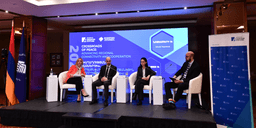
Asmin Kavas,PhD
Eskişehir Osmangazi UniversityFaculty of Economics and Administrative Sciences
Faculty Member (asst. prof)
Related Publication Files

Ankara – Findings of the project on “Syrians in Istanbul and Post-War Syrian Ghettos” was discussed on Thursday, April 18, 2019 at the Economic Policy Research Foundation of Turkey (TEPAV). Migration is an urban issue almost everywhere including Turkey. The major objective of the project, carried out by TEPAV and funded by Heinrich Böll Foundation - Turkey Representative, is to discuss how Syrian migrants are living in Turkey by navigating the post-war ghettos in Fatih, Sultanbeyli, and Sultangazi districts of Istanbul where there is a dense Syrian population.
The event started with TEPAV’s managing director, Guven Sak, welcoming remarks whose speech drew attention to the following: “The situation of Syrians in Turkey is too important to be overlooked. With regard, the phenomenon of ghetto and the ghettoization process is of an utmost importance. As such, we first investigated the concept of post-war ghettos in Önder, Ankara, for being a large settlement area of Syrians in the capital city of Turkey. We ended up with remarkable results and the research in Önder is the basis of our work in Istanbul. Therefore, we are happy today to share with you the results of our work. We also thankful to Heinrich Böll Foundation office in Turkey for the support in realizing this project.”
Dr. Asmin Kavas, the project manager, explained in her remarks that a ghetto is a concept that portrays the parts of a city which have not been integrated with or caused to be segregated from other living spaces. The concept, moreover, describes an urban area where the social and residential factors intersect through clustering formed by idiosyncratic lifestyles and sociocultural affinities where homogenous areas are created, promoting social and residential segregation within the heterogeneous structure of the city.
In addition, Kavas highlighted residential segregation, homogeneous relationship, social exclusion, area isolation, and population density constitute the main variables that differentiates a ghetto from other habitats. Furthermore, and under the scope of the project, a total of 370 people in Fatih, Sultanbeyli, and Sultangazi were interviewed to verify the aforementioned five variables to determine the areas where post-war Syrian ghettoization is taking place.
The areas covered within the research where Syrians have formed ghettos were the neighborhoods of Akşemsettin and Ali Kuşçu in Fatih and İsmetpaşa and Zübeydehanım in Sultangazi. To begin with, the findings from these neighborhoods showed that Syrians in the two districts had limited access to local services, effectively indicating social exclusion. Moreover, and in both districts, there was not a direct service area produced within the scope of social cohesion / integration for Syrians. Instead, the services prioritized offering solutions to the complaints of Turkish citizens toward Syrians.
Moreover, the results revealed that the majority of the workplaces operating in the covered neighborhoods of the two districts were operated by Syrians. This combined with population density triggered an economic homogenous relation as Syrians’ day-to-day buying habits were largely restricted between themselves. Furthermore, the results indicated that Syrians do not communicate with the Turks, preferred to speak Arabic, and reflected cultural differences by the clothing they wore and reflected own traditions in the places where they worked and lived.
On the other hand, and unlike Fatih and Sultangazi, there is a strong policy and effective dialogue platform in Sultanbeyli. The Sultanbeyli Refugee Association, established under the auspices of Sultanbeyli municipality in 2014, offers 19 municipal services. A critical one is the data registration system called SUKOM, which was developed as an in-house software to strengthen social cohesion between Syrians and the local community by limiting the formation of population clusters. The database, moreover, obtains a demographic breakdown of Syrians in Sultanbeyli – a scarcity at the local level – and updated at regular intervals. For example, and according to the database, the crime of Syrians in the district of Sultanbeyli was 8 percent. Furthermore, and in contrst to Fatih and Sultangazi, the hosting community in Sultanbeyli did not uphold negative perceptions about Syrians. Indeed, 85 percent of the interviewed Turks indicated that they have not been disturbed by living with Syrians. This could be mainly attributable to the invisibility of Syrians as they are widespread in the district. This, in addition to absence of social exclusion and accessibility to municipal services, effectively conformed the lack of a ghetto in Sultanbeyli, Kavas added.
All in all, the preliminary results shared during the event covered the living dynamics between Syrians and the hosting community in three urban settings of Istanbul. The presence of post-war Syrian ghettos, and the lack thereof in one district, demonstrates the importance of inter-agency cooperation and coordination between localities and NGOs in delivering effective data-driven services. Hence, generating a sphere of co-existence and social cohesion between Syrians and Turks.
For the full results of the project, please click here




